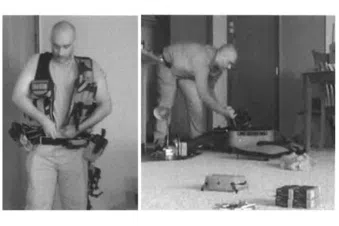
Barakat tries on a tactical vest, left, and minutes later loads weapons into a suitcase before leaving his apartment on the morning of July 14, 2023
FARGO (AP) — Newly released investigative reports into last year’s deadly ambush of police officers in Fargo show the gunman loading his weapons into a garage and visiting a gun range hours before the attack.
The trove of investigation documents released Thursday includes a timeline of images from Mohamed Barakat’s apartment and surveillance cameras that map his movements before the July 14 shooting as officers investigated a routine traffic crash. Barakat shot and killed one Fargo police officer and wounded two other officers and a bystander before a fourth officer killed him in an exchange of gunfire. Investigators have said they believe Barakat was planning a larger attack.
Images taken from video on the night before the shooting show a tactical vest on Barakat’s apartment floor, Barakat checking his door while holding a gun and a cellphone, and later assembling a short-barreled shotgun. After midnight, he’s seen holding a Quran.
The next morning, the 37-year-old gunman is seen accessing trail cameras via his computer and deleting files, holding guns, donning a tactical vest and loading a suitcase before leaving his home with the suitcase, a rifle case and a bag. He secured his door with a strap or cable and returned at least twice that day to check on it.
The report doesn’t specify how the images were captured inside Barakat’s home.
He spent about 20 minutes at a gun range about 20 miles west of Fargo, then bought gasoline and cigarettes at a nearby convenience store and a beverage at a dollar store, the documents show.
Much of his subsequent movements involved driving around Fargo, returning several times to his garage and at least twice to his apartment. He loaded gas cans into his car, drove off again, then returned to his apartment building where he argued with a manager at the front door. The timeline doesn’t detail the argument.
After Barakat left his garage for the last time, he drove near the site of a fender bender on a busy street. North Dakota Attorney General Drew Wrigley has said he watched, waited for and targeted the responding officers.
Wrigley has already released or showed videos from the officers’ body cameras, a police car dashboard camera and a nearby business depicting Barakat driving around the crash scene before parking and opening fire.
“It’s fair to deduce from all of this that he is clearly targeting the police,” Wrigley said in August.
Barakat lived alone in an apartment, working odd jobs. He had no criminal record or social media presence, authorities said, and had so little contact with others that the only photo that investigators initially provided was a blurry image taken from a video.
Barakat shot and killed 23-year-old Officer Jake Wallin — who managed to fire one round before he died — and wounded Officers Andrew Dotas and Tyler Hawes. A driver who had rear-ended another vehicle in the crash was also wounded.
Barakat waited until the officers moved closer to him, into a grassy area to interview crash witnesses, before he opened fire from his vehicle with no apparent warning. He used a .223-caliber rifle that had been modified with a binary trigger to unleash a torrent of bullets, some of which hit passing cars and nearby homes.
A fourth officer, Zach Robinson, fired back with a 9 mm handgun, shooting the clip of Barakat’s rifle and effectively disabling it. Robinson called for backup then ran toward danger as Barakat moved between parked cars.
The video shows the wounded Barakat on the ground, ignoring Robinson’s commands to drop his weapon. Robinson fired five more shots. After nearly two minutes, 21 of the 31 shots Robinson fired had struck the gunman.
The investigative files included photos taken of Barakat’s car showing blood stains and bullet holes, but also the arsenal he brought with him.
The photographs show more than a dozen spent shell casings that landed on the driver’s side floor and in the windshield and heating vent of the car. They also show gas canisters and another long gun in the backseat, a propane tank in the front passenger seat, and another propane tank and gasoline canister in the trunk.
Investigators also found 1,800 rounds of ammunition and a homemade grenade.
Barakat was a Syrian national who sought asylum in the U.S. in 2012 and became a U.S. citizen in 2019, Wrigley said. Concerns about his collection of at least 10 guns and 6,000 rounds of ammunition prompted police to interview Barakat at his home at least twice, but he appeared to have acquired the weapons legally.
After the attack, investigators examining Barakat’s internet history found that over the past five years, he had searched for terms including “kill fast,” “explosive ammo,” “incendiary rounds,” and “mass shooting events.” The day before the shooting, he searched for “area events where there are crowds,” which brought up a news article with the headline, “Thousands enjoy first day of Downtown Fargo Street Fair.”




Comments